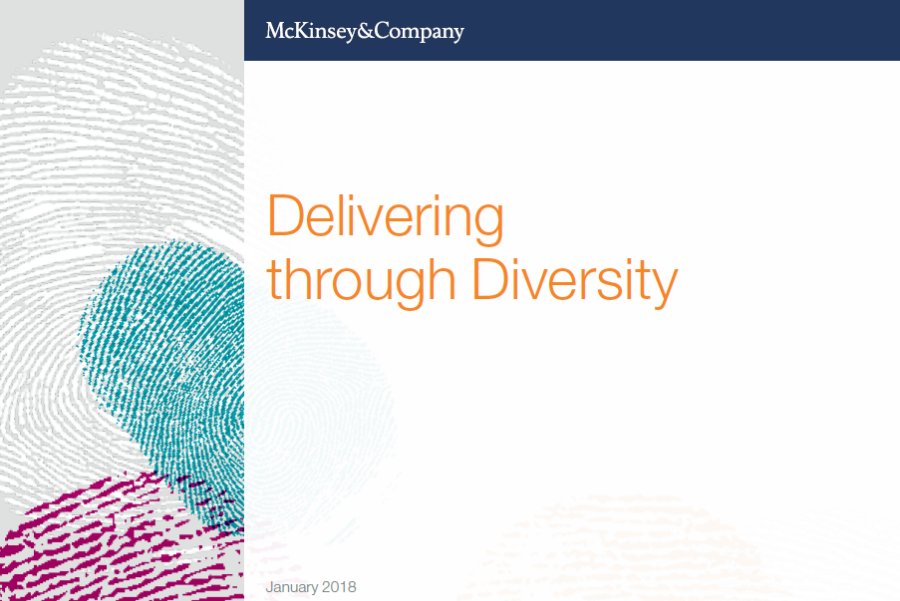McKinsey report ‘Delivering through diversity’

The latest research by McKinsey & Co. reinforces the link between diversity and company financial performance and suggests how organizations can craft better inclusion strategies for a competitive edge. Its latest study of diversity in the workplace entitled 'Delivering through diversity' reaffirms the global relevance of the link between diversity—defined as a greater proportion of women and a more mixed ethnic and cultural composition in the leadership of large companies—and company financial outperformance.
The new analysis expands on their 2015 report, Why diversity matters, by drawing on an enlarged data set of more than 1,000 companies covering 12 countries, measuring not only profitability (in terms of earnings before interest and taxes, or EBIT) but also longer-term value creation (or economic profit), exploring diversity at different levels of the organization, considering a broader understanding of diversity (beyond gender and ethnicity), and providing insight into best practices.
Diversity and financial performance in 2017
In the original research, using 2014 diversity data, they found that companies in the top quartile for gender diversity on their executive teams were 15 percent more likely to experience above-average profitability than companies in the fourth quartile. In the expanded 2017 data set this number rose to 21 percent and continued to be statistically significant. For ethnic and cultural diversity, the 2014 finding was a 35 percent likelihood of outperformance, comparable to the 2017 finding of a 33 percent likelihood of outperformance on EBIT margin; both were also statistically significant.
Ethnic diversity in the executive team and board correlates with stronger profitability.
Ethnic and cultural diversity on executive teams is low. McKinsey focused on their US and UK data sets to examine ethnically and culturally diverse representation among US and UK companies, considering the pipeline starting with university graduates.
- Black Americans comprise 10% of US graduates but hold only 4% of senior-executive positions
- Hispanics and Latinos comprise 8% of graduates versus 4% of executives
- Asian Americans, the numbers are 7% of graduates versus 5% of executives.
In the United Kingdom, the disparity is even greater: 22 percent of university students identify as black and minority ethnic, yet only 8 percent of UK executives in their sample do.
Black women executives are underrepresented in line roles and may face a harder path to CEO. As discussed, within their US and UK data sets, overall representation of women on executive teams shows an apparent bias toward staff roles. Among their US sample, not only do women hold a disproportionately small share of line roles on executive teams but also women of color (including Asian, black, and Latina women) hold an even smaller share.
Diversity around the world
The correlation between gender and ethnic diversity and financial performance generally hold true across geographies, though with some variations in certain regions. Their data yielded some noteworthy findings concerning the country-level differences in executive-team diversity:
Australian companies lead the way when it comes to the women’s share of executive roles (21 percent). The share in the United States is 19 percent and in the United Kingdom is 15 percent. The same holds true for board positions, with Australian companies at 30 percent, US companies at 26 percent, and UK companies at 22 percent—and for women at the whole company level. The disparity among these countries is interesting, given that women’s participation in the workforce is similar in all three and given that they dominate among top performers, representing 47 percent of the data set but more than 70 percent of the top-quartile companies.
When considering ethnic-minority representation in the broader population, British executive teams seem closer to achieving a “fair share.” This, however, masks huge variations within the UK data set, in which a large proportion of companies have no ethnic minorities on their executive teams (or boards) and a handful of companies have particularly international executive teams. Ethnically diverse representation on UK and US executive teams increased by an average of six and five percentage points, respectively, since 2014. However, this was offset by declines in other geographies, leading to an overall lower increase of one percentage point across regions.
Delivering impact through diversity
Four imperatives emerged as being crucial to delivering impact through diversity:
Articulate and cascade CEO commitment to galvanize the organization. Companies increasingly recognize that commitment to inclusion and diversity starts at the top, with many companies publicly committing to an I&D agenda. Leading companies go further, cascading this commitment throughout their organizations, particularly to middle management. They promote ownership by their core businesses, encourage role modeling, hold their executives and managers to account, and ensure efforts are sufficiently resourced and supported centrally.
Define inclusion and diversity priorities that are based on the business-growth strategy. Top-performing companies invest in internal research to understand which specific strategies best support their business-growth priorities. Such strategies include attracting and retaining the right talent and strengthening decision-making capabilities. Leading companies also identify the mix of inherent traits (such as ethnicity) and acquired traits (such as educational background and experience) that are most relevant for their organization, using advanced business and people analytics.
Craft a targeted portfolio of inclusion and diversity initiatives to transform the organization. Leading companies use targeted thinking to prioritize the I&D initiatives in which they invest, and they ensure there is alignment with the overall growth strategy. They recognize the necessity of building an inclusive organizational culture, and they use a combination of “hard” and “soft” wiring to create a coherent narrative and program that resonates with employees and stakeholders, helping to drive sustainable change.
Tailor the strategy to maximize local impact. Top and rapidly improving companies recognize the need to adapt their approach—to different parts of the business, to various geographies, and to sociocultural contexts.
Download Delivering through diversity, the full report on which this article is based (PDF - 7 MB).
About the author(s)
Vivian Hunt is a senior partner in McKinsey’s London office, where Sundiatu Dixon-Fyle is a senior expert; Sara Prince is a partner in the Atlanta office; Lareina Yee is a senior partner in the San Francisco office. The authors wish to thank Treina Fabré and Saif Hameed for their contributions to this report.




